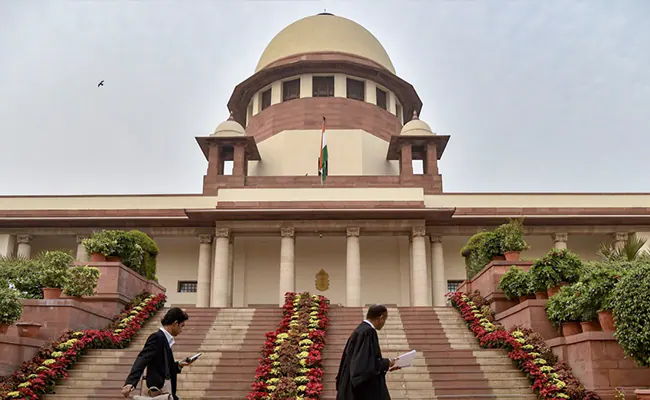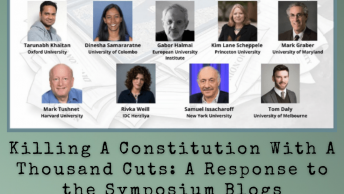The idea for this post arose from a simple observation: although France is considered to be one of the places where the theoretical foundations of limits on constitutional amendments were laid, constitutional amendments are not limited in the current interpretation given to the French Constitution. On the contrary, if we leave France, discussions on the nature of constituent power were, and still are, very much alive in India, where the Supreme Court, with the Basic Structure doctrine, can review and annul constitutional amendments. While the revision of the French Constitution is still on the government’s table, the comparison between France and India raises a question: Should the basic structure doctrine be imported into France to protect the Constitution from the executive? The aim of this post is to show that the basic structure doctrine could prove useful in France. However, the usefulness of a doctrine capable of restricting the scope of constitutional amendments should not be assessed solely on strictly legal grounds. Constitutions are not just legal documents; they also perform a symbolic and integrative function that can help society to understand and construct its own identity. Consequently, a basic structure grounded in explicit limits to constitutional amendments provided for in the French Constitution can contribute to determining a constitutional identity organised around the idea and meaning of the Republic as a political organisation where the power is shared between members of society.
The idea of constituent power is closely associated with the revolutionary period in France. In 1789, Emmanuel Joseph Sieyès, while working out the theoretical foundations of the regime to replace absolute monarchy, developed the distinction between constituent and constituted powers. The former, an emanation of the sovereign Nation, is absolute; it conceives the constitution and, therefore, provides a framework for constituted power, which exists only within the Constitution and thanks to it. This first distinction was supplemented by another during the discussions of the National Assembly in 1791, where the members distinguished between original constituent power and derived constituent power. The original constituent power drafts the Constitution; it is sovereign and absolute and oversees the exercise of the derived constituent power, which is the power to amend the Constitution. Hence, this distinction makes it possible to consider the limits of constitutional amendments, the original constituent power having the capacity to impose limits on the exercise of derived constitutional power.
As far as French constitutional history is concerned, the majority of constitutions written in France have used these distinctions to limit the power of amendment formally. As a symbol, the most famous limiting provision was added in 1884 to the constitutional laws of 1875 of the Third Republic by way of amendment. By stating that “the republican form of government may not be the subject of a proposal for revision”, this provision enshrines the Republic to the detriment of the monarchy and establishes a Republican form of government that is still followed today. Indeed, the following constitutions have respected this principle, and it is to be found today in the last paragraph of the last article of the current French Constitution concerning constitutional amendments: Article 89, paragraph 5.
Nevertheless, in spite of this explicit limitation provided for by the constitutional text itself, the French Constitutional Council has never asserted its jurisdiction to review constitutional amendments. In two significant decisions, the Council, while recognising the existence of explicit limits to constitutional amendments, refused to review constitutional amendments in relation to these limits. The Council’s jurisdiction is governed by the Constitution, which does not give it the power to review constitutional amendments. This position can be explained by the troubled history of the Council and the conception of the sovereign in France. Some might question the usefulness of discussing the limits on constitutional amendments in France today. It has been fifteen years since the Constitution was last revised, and every President who has wanted to amend the Constitution has encountered opposition from the Senate, the upper house of the Parliament, whose consent is required to amend the Constitution. Why need limits on constitutional amendments if the revision process itself prevents any amendment?
First, the difficulty of a revision today is no indication of the difficulty of a revision tomorrow since an agreement can be reached between the main French political parties to amend the constitutional text. Therefore, enforcing constitutional limits to constitutional amendments can still be useful for controlling future constitutional amendments. Moreover, as the Indian history of the basic structure doctrine indicates, the limits on constitutional amendments have a wider scope: they also define the fundamental characteristics of the constitutional system and thus help to understand the identity of the Constitution. In this respect, each limitation on constitutional change can be seen as a feature of the identity of a constitutional system. Thus, in Kesavananda, Justices Shelat and Grover, while identifying fundamental rights and Directive Principles of State Policy as fundamental features of the Constitution, declared that without these features, “its identity would be completely changed.” Recognition of a constitutional identity can, therefore have a symbolic and integrating purpose: by recognising the essential characteristics of the constitution, the constitutional courts create a narrative around the constitution so that citizens can identify with the constitution and thus feel integrated into the constitutional state. For example, the transformative narrative crafted by the Supreme Court of India since 2018 could be seen as possible because of the identification of Fundamental Rights and Directive Principles as basic features of the Indian Constitution. Thanks to its basic features, the Indian Constitution is represented through the Supreme Court as a liberal and social text capable of garnering the commitment of Indian society.
Still, the difficulty of this enterprise lies in the identification of the fundamental characteristics of the Constitution. The Supreme Court of India has identified, for example, secularism and federalism as basic features of Indian constitutional identity, but this identification was made by the judges without explicit textual indications. In France, in contrast, Article 89, paragraph 5 creates a limit on constitutional amendments and can serve as a textual basis for the construction of a French constitutional identity. This provision, which has been in force since 1884, could also contribute to the creation of a constitutional structure bringing together all the Republican Constitutions in force in France. In this respect, such a constitutional identity is in line with the case law developed by the French Constitutional Council. Since 1971, the Council has used the “fundamental principles recognised by the laws of the Republic” proclaimed in the Preamble to the 1946 Constitution of the Fourth Republic to review the law. These principles are not enumerated in the text of the Preamble but are discovered by the Councillors in the ordinary laws enacted under a republican Constitution. For example, given their history and implementation, the rights of defendants in a trial and academic freedom have been recognised as fundamental principles recognised by the laws of the Republic. This recognition by the Council gives them constitutional authority so councillors can use them to review ordinary laws. Paragraph 5 of Article 89 can thus serve the same purpose as those principles but to limit constitutional amendments. “The Republican form of government” may be interpreted broadly by the Council to have material content supplied by the French Republican Constitutional experiences. This content would, therefore provide the basic attributes of the Republican form of government in France and could help to understand the meaning of the Republic in France so that people can identify with it.
To sum up, the Indian idea of the basic structure can be adapted in France in light of the country’s republican history. More than a device limiting constitutional amendments, this republican structure may be used to identify the basic features of French republican history so that citizens can identify themselves with it. However, the main problem arises from the position of the French Constitutional Council: Is it really willing to overturn its previous decisions? Does it have sufficient legitimacy to do so? Does it really want to embark on a process of identity-building and integration through the Constitution? In any case, a republican constitutional structure built on Article 89, paragraph 5 can act as a starting point for discussing France’s republican identity. This discussion can begin with the constitutional bodies but can also be extended beyond them.
Antonin Vergnes is a doctoral student in comparative constitutional law at the University of Bordeaux, France. His research is in the field of comparative constitutional law, with a particular focus on the Indian Constitution, constitutional social rights and transformative constitutionalism.
This piece was coordinated by Avani Vijay and edited by Archita Satish and Avani Vijay from the Student Editorial Team.








Hi Its a Valuable Information about law
Hi Thanks For Sharing Great Blog